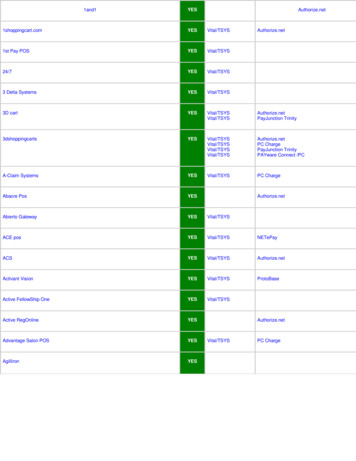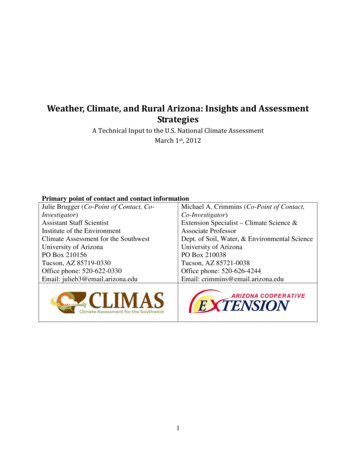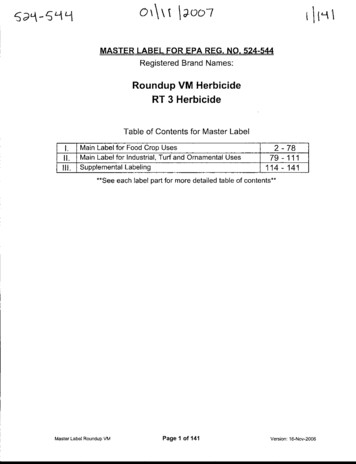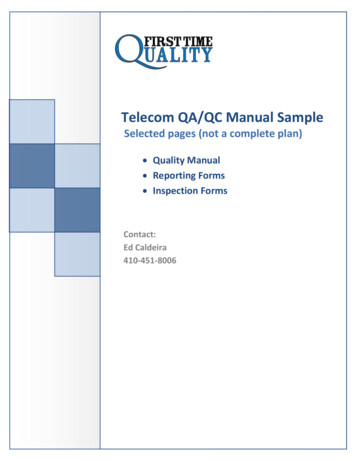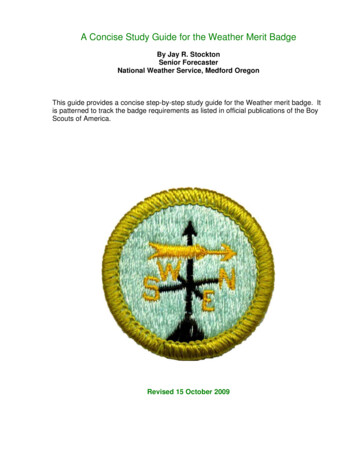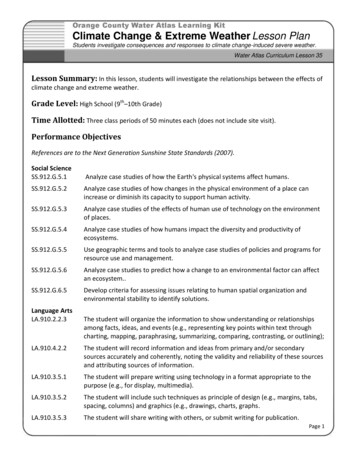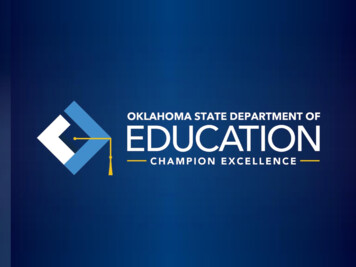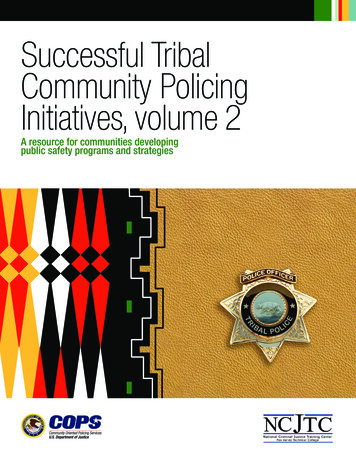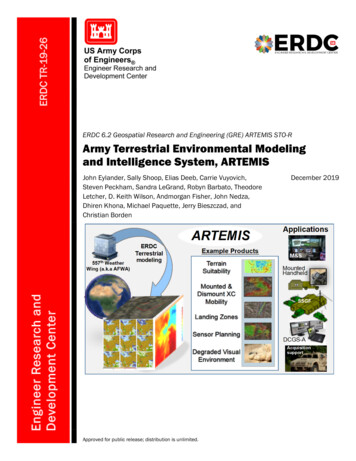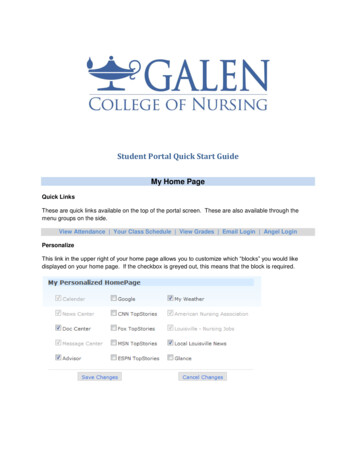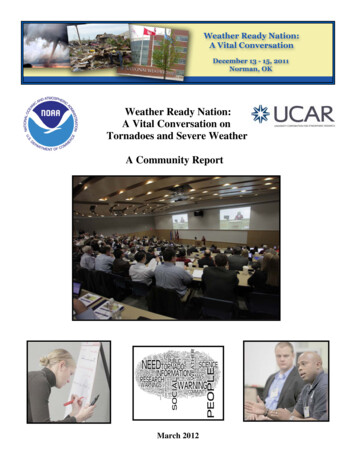
Transcription
Weather Ready Nation:A Vital Conversation onTornadoes and Severe WeatherA Community ReportMarch 2012
Executive CommitteeDr. Berrien Moore (chair)Dr. Louis Uccellini (chair)Dr. Kathryn SullivanDr. Jack HayesMr. Ray BanMr. David CaldwellMs. Margaret DavidsonDr. Kelvin DroegemeierDr. Pam EmchMr. Bob GoldhammerDr. Bill HookeDr. Tim KilleenDr. Shirley LaskaDr. Mark LevitanDr. Sandy MacDonaldDr. Mike MorganDr. Robert O'ConnerDr. David PrevattDr. Joe TrainorDr. Roger WakimotoMr. Sam WilliamsonCollege of Atmospheric & Geographic Sciences/University of OklahomaNational Centers for Environmental Prediction (NCEP)/NWS/NOAANational Oceanic and Atmospheric Administration (NOAA)National Weather Service (NWS)/NOAAThe Weather ChannelOffice of Climate Water and Weather Services (OCWWS)/NWS/NOAANational Ocean Service (NOS)/NOAAOffice of the Vice President for Research/University of OklahomaNorthrup GrummanInternational Association of Emergency ManagersPolicy Program/American Meteorological SocietyGeosciences/National Science Foundation (NSF)Sociology/University of New OrleansEngineering Laboratory/National Institute of Standards and Technology (NIST)Office of Atmospheric Research (OAR)/NOAADivision of Atmospheric and Geospace Sciences/NSFDecision, Risk and Management Sciences/NSFDepartment of Civil and Coastal Engineering/University of FloridaDisaster Research Center/University of DelawareNational Center for Atmospheric Research (NCAR)Federal Coordinator for MeteorologyDr. Russell Schneider (Chair)Mr. John Ferree (Chair)Dr. Steve Koch (Chair)Mr. Don BerchoffMs. Andrea BleisteinMr. Matt BorgiaMr. Kenneth CareyCpt. Barry ChoyMs. Nancy ColletonDr. Brad ColmanMr. Tom FahyMr. Mike FosterDr. David GreenMr. Douglas HilderbrandMr. Eli JacksMr. Kevin KelleherDr. Jeff LazoMs. Suzanne LenihanMr. Barry MeyersMr. Kevin ScharfenbergDr. Tim SpanglerMs. Jennifer SpragueMr. Andy SternMs. Heidi StillerMs. Keli PirtleMr. Christopher VaccaroMs. Ann WeaverStorm Prediction Center/NWS/NOAAOCWWS/NWS/NOAANational Severe Storms Laboratory (NSSL)/OAR/NOAAOffice of Science and Technology (OST)/NWS/NOAAExternal Affairs/NOAALegislative Affairs/NWS/NOAACenter for Sustainability: Earth, Energy, and Climate/NoblisNCEP/NWS/NOAAInstitute for Global Environmental StrategiesSeattle Weather Forecast Office (WFO)/NWS/NOAACapitol GR GroupNorman AANSSL/OAR/NOAASocietal Impacts Program/University Center for Atmospheric Research /UCARStrategic Planning and Policy/NWS/NOAAOCWWS/NWS/NOAANOS/NOAAOffice of Communications/NOAAOffice of Communications/NWS/NOAANOS/NOAAOrganizing Committee2
Weather‐Ready Nation:A Vital Conversation on Tornadoes and Severe WeatherReport from the December 2011 SymposiumPrologueOn the 13th of December 2011 at the National Weather Center in Norman, Oklahoma, a nationalconversation began on what it takes for our country to become a “Weather‐Ready Nation.” The dialoguebrought together social scientists and physical scientists, operational forecasters and TV meteorologists,first responders and emergency managers, and private entrepreneurs and government officials fromacross the country. The tragic toll from the tornadoes of 2011, in which 550 Americans died and thenation sustained billions of dollars in economic damage, called for diverse concerned communities tocome together to build a broader and stronger alliance against future loss. The over‐arching goal of thisdialog is to identify, prioritize, and set in motion actions to enhance our nation’s preparedness andresilience for severe weather, especially tornadoes, so that fewer American lives are lost and the nation’seconomy made more secure. This said, a Weather‐Ready Nation needs to be ready for weather in all of itsforms. During the second half of 2012, the focusing lens of tornadoes will be replaced by broaderconsiderations of severe weather: hurricanes, droughts, floods, fire, heat waves as well as tornadoes.We came together with a goal to develop a cohesive community of scientists, practitioners, and users whoare committed to advancing an emerging and more unified paradigm that focuses more systemically on awarning system that will ultimately reduce the loss of life and mitigate the social and economic impactsfrom severe weather. We believe we must grow and sustain effective partnerships between those whoconduct both physical and social science research as well as with those who create, communicate orreceive forecasts. All recognize that only a comprehensive end‐to‐end warning system combined withappropriate improvements in both our communities and building standards can optimally protect livesand property while also improving the nation’s resilience to severe weather. This partnership supportsthe promise of a Weather‐Ready Nation: a nation that is better informed because of our focuseddiscussions and thus, better prepared by resulting actions.We committed to facilitating a purposeful national conversation focused on actions to reduce the loss oflife and social and economic impact of severe weather. Nature, as it always has, will replay the powerfulforces unleashed during 2011, and other communities and cities will suffer. But henceforth, we pledge tobe ever more ready; informed by new knowledge forged through these new partnerships, enabled bynew tools that better serve the needs of people, and united though our shared resolve and focused effortsto change the future. Readiness will not all happen tomorrow or the next day, but it will happen.We identified, through this initial national dialog, a number of challenges to becoming a Weather‐ReadyNation. In the months ahead, there will be a series of research‐ and operations‐oriented, interdisciplinaryworkshops and symposia, designed to energize and integrate a broad coalition of contributors —researchers, emergency managers, first responders, broadcast meteorologists, private and public sectors,and educators.In partnership with the National Oceanic and Atmospheric Administration (NOAA) and other keypartners, future gatherings will refine and prioritize actions directed toward producing both measurablereductions in the loss of life and avoidable damage to the American economy.We will see this through; the United States of America must become a Weather‐Ready Nation.
Section 1: OverviewDespite excellent warnings and longer than average lead times, 550 lives were lost in tornadoes in 2011.This made 2011 one of the four deadliest tornado years in U.S. history, joining the tragic death tolls of1917, 1925, and 1936. On December 13‐15, more than one hundred and seventy five national experts andleaders including emergency managers, academics, social scientists, government and private sectorweather forecasters, communication experts, news media and decision‐makers gathered in Norman,Oklahoma to initiate a focused national conversation. Their goal was to "identify, prioritize, and set inmotion actions to improve the nation's resiliency against severe weather, especially tornadoes, to protectlives and property."This national summit was the first in a series of Weather‐Ready Nation conversations that NOAA willfacilitate across the country in 2012 to learn from the experience and insights of important weatherpartners and, where appropriate, to initiate actions to increase readiness. The initial priorities from theDecember meeting focused on how to improve impact‐based forecasts and warnings, sharpen science‐service linkages, and identify enhanced communication and service delivery innovations. Other areas willrequire further definition. As Section 5 notes, there will be ample opportunity for this needed shapingand refining as the base for further actions.Section 2: Presentations and Panel DiscussionsNOAA Administrator Dr. Jane Lubchenco opened the event by videoconference and set the tone fordecisions and actions by offering her support, urging a unified effort to listen and learn and to generatesustained interactions that enable the community to collaboratively chart a way forward. OklahomaGovernor Mary Fallin then gave the first Keynote Address and noted the importance of our work thatincluded the safety of our citizens and industries. Jack Hayes, director of the National Weather Service(NWS), echoed this theme, stating “Becoming a Weather‐Ready Nation is a shared responsibility from thefederal government to the individual citizen and everyone in between.” He pledged, “NOAA’s NationalWeather Service is committed to delivering the highest quality of forecast and warning services andfostering innovation. Building a Weather‐Ready Nation will take the commitment of everyone we’reengaging with through these national conversations.”The days were filled with the expectation that with discussion, collaboration and commitment, therewould be opportunity for real progress. Dr. Kathryn Sullivan, Assistant Secretary of Commerce forEnvironmental Observation and Prediction, closed the meeting. In her summary statements of themeeting, she noted, "conversation is the seminal technology of all societal change."To contribute to this seminal technology and join the conversation, check out the NWS Facebook page orthe Weather‐Ready Nation web page: http://www.weather.gov/com/weatherreadynation. The completeWorkshop Agenda is provided in Appendix A1.Topics covered through presentations and panel discussions included: A summary of fundamental physical science knowledge and challenges Assessments of the major events of 2011 Improving NOAA forecasts and warnings for severe weather Improving service delivery1All plenary sessions from "Weather Ready Nation: A Vital Conversation" can currently be viewed on the workshop web site:http://www.joss.ucar.edu/events/2011/weather ready/index.html
Sharpening the science‐service linkageLeveraging community planning and impacts mitigationPoignant personal accounts of the challenges of responding to major disasters in populated areas fromJoplin/Jasper County Emergency Management and a fireman from the Fire and Rescue Service inTuscaloosa were sobering and heightened the sense of community commitment.Section 3: Cross Cut Group DiscussionsParticipants were first grouped into "Communities" of expertise:communications, emergency decision makers, operations, physicalscientists, policy specialists, risk management and communityresiliency, and senior management (See Section 4). Each communitygroup identified critical issues hindering the nation's resiliencyagainst tornadoes. Participants were then divided into cross‐community groups ("Cross Cut Breakouts") in which attendeesshared perspectives of events of 2011 and their unique professionalinsights on the challenges we must overcome to meet our goals. Thediversity of participation within the Cross Cut sessions produced aset of themes which were used to inform the community groups asthey reconvened during the final sessions of the symposium.The following themes emerged from the Cross Cut Sessions:Figure 1: Word Cloud from Cross Cut Session notes.Most common words in notes are in largest font. Strongly integrate social and physical science into the future end‐to‐end weather forecast andwarning process – from research to operations. All breakout groups indicated publicunderstanding of warnings and their perceptions of risk are important gaps, and recommendedearly and more effective integration of social science in warning policy, plans, and programs. Theissue of perception of risk may be especially important. Carefully review warning false alarms to determine physical science improvements and otherstrategies that can be used to reduce false alarms without decreasing threat detection andwarning lead‐time. Breakout groups expressed concern that public responsiveness is negativelyaffected by a perception that too many warnings are false alarms. Assess and update warning dissemination strategies. New wireless technologies afford a greatopportunity to improve the speed and effectiveness of severe weather warnings. At the same time,the strategy must not leave behind segments of the population who do not use or have access tomore modern technologies. Advance physical modeling of severe weather to provide the improved lead‐time, accuracy andprecision necessary to enable tornado warnings based on weather forecast model output (“Warnon Forecast”). Today’s critical dependence on weather radar observations for warning the publiclimits warning lead times in most cases to approximately 15‐20 minutes. Improve outreach and education to supported agencies and groups: Federal EmergencyManagement Agency (FEMA), emergency managers, threatened communities. Breakout groupsagreed that preparation requires credible communication of threat, which leads to proactivelyplanning on the part of communities and individuals. There is also a need for all to better5
understand the scientific certainty and uncertainty inherent in extreme weather forecasting andwarnings. Evolve the National Weather Service (NWS) Assessment process that follows major severeweather outbreaks to be similar to assessments of the National Transportation Safety Board(NTSB) that follow major transportation disasters.2 The assessment teams would includeexternal/independent experts alongside NWS staff. Increased participation and visibility wouldtrigger broader national action to go beyond simply living with the personal and economicimpacts of extreme weather. Build coalitions with corporate America. Such coalitions could significantly enhance theeffectiveness of government issuances and thereby have great potential to make a difference.A more complete list of ideas from the Cross Cut sessions is available in Appendix B.Section 4: Recommendations by CommunitySeven community groups that met at both the beginning and the end of the symposium were given thetask to identify and prioritize actions to improve the nation's resiliency against severe weather, especiallytornadoes, to protect lives and property. The intervening cross cut discussions helped to inform andenrich the community‐specific final session during which priority actions to reach our shared goals weredeveloped. There is welcome and important overlap between the recommendations of Section 3 andSection 4. Finally, these recommendations were presented and discussed at a Town Hall at the AmericanMeteorological Society’s Annual Meeting in January 2012. These recommendations form the primary setof Action Items.The top prioritized recommendations from the seven communities (in alphabetical order) are listedbelow.A. Communications Group Create Research/Resource Centers in which social and physical scientists can work withforecasters and/or forecast users to ensure successful communication of extreme weather threats.Such centers, some of which might be “virtual,” would focus on fundamental social scienceresearch issues and on transitioning social science research on such topics as public threatperception, messaging to improve public understanding and responsiveness to warnings, etc. intooperational practice. The centers would also address the limits of the science by both extendingthe known into the unknown and by better a) defining and communicating what the science hasestablished, and b) identifying what remains uncertain and thus requires further research.Review and improve warning dissemination strategies and technologies to increase effectiveness.The population is segmented: by age, income, schedules, technology awareness and access. Thiscreates different vulnerabilities and requires multiple communication strategies. Informationaccess for vulnerable populations, including preparedness efforts, is particularly important.Delivery systems pose several issues including technology access. For instance, the use of geo‐2The National Construction Safety Team (NCST) Act of 2002 (PL 107-231) authorized National Institute of Standards andTechnology (NIST) to conduct investigations involving damage to buildings that caused or could have caused substantial loss ofhuman life. This legislation was modeled after the NTSB. The NIST study of the Joplin tornado is being conducted under NCSTauthority. See http://www.nist.gov/public affairs/factsheet/constructionact.cfm6
located polygons versus county level warnings (e.g., How do you convey a polygon on NOAAWeather Radio?), language and mobility barriers, hearing/visual impairments, and socio‐economic groups. These issues need to be carefully considered and addressed.Study the warning false alarm issue and develop/implement strategies that increase publicresponsiveness to warnings. The issue of false alarm needs to be addressed. There are numerousissues, including perceptions of false alarms. As the science of prediction improves, the issue offalse alarm will obviously change but in ways that may not be obvious. This will change bothbecause of operational changes and the scientific gains. Understanding better the various falsealarm issues is essential.B. Emergency Decision Makers Group Modernize NOAA Weather Radio (NWR) using a public‐private partnership to address theincorporation of polygons or other more refined geo‐location techniques. Other topics that need tobe addressed are:o GPS integrated programmable radio that only activates for tornado warnings where theradio is located.o Increase coverage density/number of NWR transmitters to fill “dead areas.”Develop clear, consistent, and concise messages issued by NWS, commercial weather services,emergency managers and the media in formats that are easily understood.Expand educational opportunities, including beyond the classroom.o Distill the existing knowledge base into useable formats that support broader educationalneeds.o Fund and use in‐progress work and tools to the point of implementation e.g. trainingmodules.o Collaborate with the Natural Hazards Research Center3 as one approach to expandinglinkage to the application community.o Identify and extend best practices nationally e.g., OK‐First training modules.4C. Operations Group 34Through targeted funding, develop the essential social science research base that will support aWeather‐Ready Nation. This is needed, in part, to find out what people need to know to receiveinformation, to prepare, to make decisions, and to take action. This requires:o Redesign of the dissemination, education, warning, and forecast services,o Incorporation of social science considerations as an integral part of the end‐to‐end warningsystem, ando Improvement of communication from top‐to‐bottom and bottom‐to‐top withinorganizations that make up the warning to response rst.mesonet.org/train/training.html7
D. Physical Science Group Conduct a needs analysis for existing, new and future observation technologies and assess theimpact on the forecast process and associated forecast skill.Address gaps in understanding with the focus, in part, on being able to predict with adequate lead‐time the physical factors that affect the genesis, longevity, track, and intensity of tornadoes(especially to reduce false alarm rates). In considering the relevant physical factors, thecommunity should develop severe storm climatologies on appropriate space‐time scales fortornadoes and conduct data mining experiments to extract the most relevant parameters fortornado prediction.Assess the feasibility of numerical prediction of convective initiation and tornadoes throughassimilation of both current and developmental radar and other fine‐scale data into high‐resolution numerical forecast models.Establish a rapid post‐storm assessment system and process similar to NTSB’s post‐accidentinvestigations. One objective of this post‐event investigation would be to determine if we needbetter warnings, engineering or response (or all/none of the above).E. Policy Specialist Group Integrate social science into NWS product development as well as NWS assessment of current(and future) business practices and workforce evaluation.Improve dissemination of an expanded suite of warning technologies including mobile devices,home safety (smoke detectors, security systems enhancements to allow warnings), reverse 911,etc.Exploit and expand storm‐based warning value‐added information into legacy disseminationsystems through Common Alerting Protocol (NOAA Weather Radio, emergency systems, sirensystems).Develop consistent but flexible ways for the NWS to issue warnings, which recognize the need toenhance consistency between NWS Forecast Offices but allowing for the addressing of local needs.Engage the Department of Commerce (DoC) in a coordinated assessment of severe weather’simpact on the country including DoC agencies such as Bureau of Economic Analysis, and the U.S.Census Bureau. Also include the independent agency, the Small Business Administration.F. Risk Mitigation and Community Resilience Group Conduct trans‐disciplinary research and other collaborative research efforts to evaluate successand failure stories and histories in risk management.Examine functionally resilient and non‐resilient communities with a particular focus on whypeople survive (or sustain injuries) or not during tornadoes.Significantly improve the scientific knowledge and engineering models to understand howbuildings fail in tornadoes, leading to better designs that can resist these forces.5 Ultimately,structurally enhanced, resilient communities must be a part of a Weather‐Ready Nation, but thesewill not occur without better understanding.Educate the public in terms of risk awareness and vulnerability. Work with state educationboards and develop vulnerability simulations to support classroom activities. Communities mustbe made aware of the risk including our existing vulnerabilities by community, and we should5A necessary place to start in assessing risk is to establish the ultimate capacities of existing structural systems. This entailsexploratory research to predict how structural framing behaves, and extensive experimental testing for developing relationshipbetween building strengths and tornado loads. Current building codes do not include design procedures for tornado loads, and so themajority of buildings away from hurricane-prone coasts lack details to mitigate tornado effects.8
include the separate constituents of leadership at all levels (community, municipal, regional,federal and state).Develop an approach for resilient buildings both for existing and new construction. Costs ofstructural enhancements for existing structures need to be explored and communities need to beaware of the tradeoffs involved in retaining old housing or outdated building codes in the face ofthe potential for future tornado strikes.G. Senior Management Group Bring Corporate America into the conversation. For example:o U.S. Chamber of Commerce; in particular the Business Civic Leadership Center6o Weather enterprise (e.g., commercial weather services)o Professional associations and other affiliated groupso Insurance and re‐insurance companieso Home builders Engage social scientists to review and provide recommendations for NWS policies associated withalerts/warnings. One objective will be to achieve more consistency.o Identify and share best practices; specifically, determine if the current advice/warnings arethe right advice/warnings.o Include the risk management community. Establish and implement processes to identify basic and applied research questions. This processshould include consideration of an assessment of the societal impacts as part of an overallprioritization of research needs. This will require a strong collaborative effort that brings togetherengineers, social scientists, and physical scientists. Conduct a review of the NWS Warning Coordination Meteorologist (WCM) program with a goal ofincluding an improved training program. This review will require social scientists to be there fromthe beginning. Start integrated research efforts related to warning false alarms that reach across the science,technologies, NWS procedures, and incentives and disincentives. One longer‐term goal is tooptimize the observing strategy and thereby make better investments.Section 5: Follow‐on ActivitiesThe conversation has just begun. This report was discussed with the community at a Town Hall heldduring the January meeting of the American Meteorological Society in New Orleans, and during the March2012 National Severe Weather Workshop in Norman.7 The discussion will continue during the AMSWashington Forum in early April8 and a late April Severe Weather Research Imperatives Symposium.The national conversation to build a Weather‐Ready Nation will continue throughout 2012 and beyondwith a number of symposia, events, town halls, workshops, and speeches.6For instance, see 2012washingtonforum.html79
Completed, Planned or Proposed Symposium and Workshops ‐‐ Location/Dates1) Weather Ready Nation ‐ A Vital Conversation (Norman, Okla.): 13‐15 December 2011 Completed: With more than 175 participants from a diverse cross section of key partners andstakeholders.2) AMS Town Hall report on Norman workshop outcomes (New Orleans, La.): 23 January 2012 Completed: More than 300 community participants. Comments and insights from the Town Halldiscussion are integrated in this report.3) National Severe Weather Workshop (Norman, Okla.): 1‐3 March 2012 Completed: Strong cross‐cutting community participation, particularly at a regional level.http://www.norman.noaa.gov/nsww/agenda/4) Proposed: 2012 National Emergency Management Association (NEMA) Mid‐Year Conference titled“Extreme Weather – Is it the New Norm” (Alexandria, Va.): 28 March 20125) AMS Washington Forum titled “Towards a Weather, Water, and Climate Ready Nation” to describeupcoming WRN actions to the community: 10‐12 April 2012 orum.html6) Weather Ready Nation: Imperatives for Severe Weather Research (Birmingham, Ala.): 23‐26 April20127) “Working Together Today to Save Lives Tomorrow" – Two high level, half day report out sessions(Washington, D.C.): May 2012 Executive Branch Focus (Federal Agencies, Chamber of Commerce, etc.) Capitol Hill Focus (Members of Congress, Relevance to District)8) Annual Natural Hazards Research and Applications Workshop (Broomfield, Colo.): 14‐17 July 20129) Proposed: AMS Summer Community Meeting (Boulder, Colo.): August 13‐16, 201210) Proposed: Annual Interdepartmental Severe Weather Community Conference: annual meeting withthe Office of the Federal Coordinator for Meteorology (OFCM)11) Proposed: National Weather Association (NWA): Social Sciences and the Weather Ready Nation:Collaboration Leading to Impact Based Decision Support Services (Madison, Wis.): 6‐11 October201212) Proposed: 2012 International Association of Emergency Managers (IAEM) Annual Conference(Orlando, Fla.): 26 October ‐ 1 November 201213) Proposed: AMS Conference on Severe Local Storms (Nashville, Tenn.): 5‐8 November 201210
14) Proposed: 2013 AMS Annual Meeting (Austin, Texas): 6‐10 January 2013 Include strong local chapter involvement in WRN communication and engagement15) Proposed: 2013 AMS Annual Meeting/Student Conference (Austin, Texas): 6‐10 January 2013Section 6: ConclusionThe Vital Conversation has begun; pathways to a Weather‐Ready Nation have been identified, and thePresident’s Proposed FY13 Budget for NOAA highlights the importance of this goal. This report presentsmore than 25 actions that will move the country to becoming Weather‐Ready.But this is a very large undertaking and additional pathways need to be charted. The opportunities forfuture dialogues are taking shape, and for the dialogues to be rich and vital, participation by many isneeded. The focus on tornadoes is but the beginning; the nation must become Weather‐Ready for allweather.This report was prepared by workshop participants under award number – NA06OAR4310119 from theNational Oceanic and Atmospheric Administration, U.S. Department of Commerce. The statements,findings, conclusions, and recommendations are those of the authors and do not necessarily reflect theviews of the National Oceanic and Atmospheric Administration or the Department of Commerce.11
APPENDIX A ‐Final Workshop AgendaNational Weather Center - University of Oklahoma, Norman, OklahomaMonday, December 125:30 – 8:00Registration, NWC Entranceway6:00 – 8:00Icebreaker, NWC Atrium - Continuous bus service available every half-hour betweenEmbassy Suites and NWC.Tuesday, December 137:30Coffee, outside NWC Auditorium8:30Welcome and Motivation, NWC Auditorium, Rm. 1313 OU - Dr. Berrien Moore NOAA - Dr. Jane Lubchenco8:45Keynote Address State Perspective - Governor Mary Fallin9:00Leadership Perspectives & Expectations NOAA/NWS – Dr. Jack Hayes – “Weather Ready Nation” FEMA – Russell Washington NCAR/UCAR – Dr. Roger Wakimoto NSF – Dr. Michael Morgan Known Challenges – Dr. Harold Brooks, NOAA-OAR-NSSL NWS: The Historic 2011 Tornado Season – Dr. Russell Schneider, NOAA-NWS-SPC Meeting Logistics – John Ferree, NOAA-NWS; Tara Torres, JOSS10:00Break10:20Impacted by the Events of 2011National Broadcast Meteorologist: Dr. Greg Forbes, The Weather ChannelNorth Carolina Outbreak Broadcast Meteorologist: Greg Fishel, WRAL-TV Raleigh, NC27 April Super Outbreak Public Safety Leadership: Ken Horst, Fire and Rescue Service, Tuscaloosa, AL; BillBullock, International Association of Fire ChiefsMay 22 – Joplin, Missouri Emergency Management: Keith Stammer, Jasper County Emergency Management11:35Major Events of 2011 – Initial Assessments12
NWS Service Assessments (2011 Super Outbreak, Joplin Tornado, North Carolina Outbreak,St. Louis Tornado): David Caldwell, NOAA-NWSPost 27 April Outbreak Survey: Dr. Gabriela Carrasco, Uni
Weather‐Ready Nation: A Vital Conversation on Tornadoes and Severe Weather Report from the December 2011 Symposium Prologue On the 13th of December 2011 at the National Weather Center in Norman, Oklahoma, a national conversation began on what it takes for our cou
